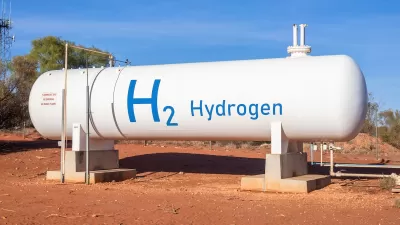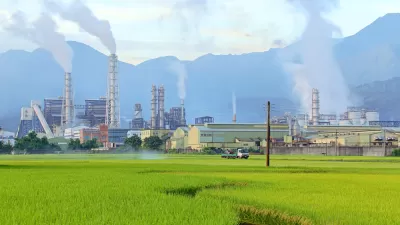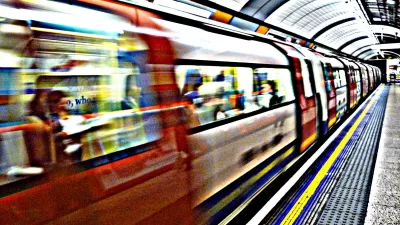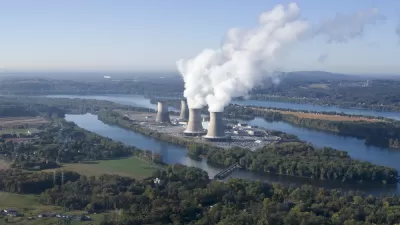Industry

First US Hydrogen Public Utility to Launch in California
The project will serve as an intermediary between clean hydrogen providers and consumers.

Carbon Emissions Down, but Not Drastically
Transportation activity is down considerably, but other sources of carbon dioxide are still going strong.

Understanding North Carolina's Urban-Rural Divide
North Carolina cities are thriving, but rural counties are not experiencing the same level of growth. Still, residents in rural areas say the numbers do not necessarily capture the whole picture.

London Underground 'Waste Heat' to Warm City Homes
Part of a plan to move United Kingdom to renewable energy involves using heat from the London Underground to heat homes.

Communities Plan for Life After Nuclear Power Plants
Nuclear power plants around the country are shutting down. The communities where nuclear plants have been located for decades will now have to figure out how to rebuild their economies without them.
Mapping America's Toy Manufacturing
All those toys under the Christmas tree came from somewhere.
Who Needs a Working Waterfront, Anyway?
The increasing recognition of waterfronts as a recreational and redevelopment asset belies its continued value for trade and industry. Will Doig makes the case for the oft-antagonized shipping industry in the tug-of-war over waterfront real estate.
Revitalizing an Industrial Mill Site as an Industrial Mill
The Faribault Woolen Mill in Faribault, Minnesota was opened in 1865, and closed in 2009. Two brothers intend to reuse the site for its original use, using an historic preservation credit to help fund the business.
California Cities Hoping Projects Lure Teams and Development
Cities across California are proposing new stadium projects in hopes of luring football teams and economic growth as a result of their new megadevelopments.
The Federal Role in Supporting Urban Manufacturing
Revitalizing American manufacturing is widely-acknowledged as vital to our country’s economic recovery and long-term prosperity, but it is equally essential to understand the changing of this sector in order to make smart policy decisions.
Seattle's Growth Through Human Capital
Despite what seemed to be a drained post-industrial condition in the 1970s, Seattle has been growing. This post looks into why.
Reviving the Waterfront -- and its Industries
Officials in New York are pushing a plan known as Vision 2020, which is aimed at restoring the city's waterfront areas and creating new public spaces. It also hopes to create preconditions for waterfront industries and businesses to grow again.
An Industrial Community Explosion in Brooklyn
The manufacturing industry is rapidly growing in Brooklyn. But unlike the black smokestacks of the past, this new industrial revolution is both green and high-tech.
Lots of Jobs, But No Housing for Workers
North Dakota is undergoing a jobs boom right now, but it doesn't have the housing stock to match the new increase in workers.
NFL Cities May Benefit From California Stadium Decision
A recent move that exempted a proposed Southern California football stadium's plans from environmental review may turn out to be precedent-setting for other cities looking to revamp their sports arenas.
Environmental Laws Bypassed for California Stadium Project
California Governor Arnold Schwarzenegger has signed a bill that allows developers of a planned football stadium in Southern California to bypass environmental laws and speed up the planning process.
Concentrated Power in Tiny City of Industry
With only 100 voters and a mayor with strong financial ties to the city, Industry, CA is "disturbingly insular," says the LA Times. And with a proposed $800 million stadium in the works, Industry's concentrated power is called into question.
Struggling Cities Meet to Brainstorm Survival Strategies
Representatives from a handful of the country's "fastest-dying cities" met recently in Dayton, Ohio to try to figure out how they could revive their economies and reverse the decline that has been slowly strangling them of jobs, money and people.
Creating a 'Carbon-Positive' City
Mayor Yu Qun has transformed the city of Baoding, China into what some are calling the world's first "carbon-positive" city -- mainly by shifting away from polluting industries to the renewable energy industry.
Design our industrial future
I previously lamented the apparent death of industrial use in our cities by the widespread application of terms like “post-industrial” and “rust-belt.” While semantics is an issue, let’s not forget that design matters and, in terms of industrial use, it hasn’t seemed to matter enough in recent years. In times past, industrial use was often a form of pride. Many of the hulking, multi-story industrial buildings in older cities are (still) beautiful additions to our cityscapes. In some cities, those that went vacant have spawned a new form of urban scavenge hunting by those seeking to fuel their appreciation for our industrial past through photography and exploration. Think as well of the WPA posters, many of which used stylized industrial themes to promote our “American” identity.
Pagination
Urban Design for Planners 1: Software Tools
This six-course series explores essential urban design concepts using open source software and equips planners with the tools they need to participate fully in the urban design process.
Planning for Universal Design
Learn the tools for implementing Universal Design in planning regulations.
Heyer Gruel & Associates PA
JM Goldson LLC
Custer County Colorado
City of Camden Redevelopment Agency
City of Astoria
Transportation Research & Education Center (TREC) at Portland State University
Camden Redevelopment Agency
City of Claremont
Municipality of Princeton (NJ)


































